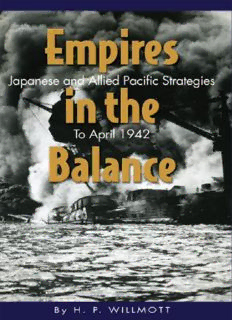
Empires In The Balance: Japanese And Allied Pacific Strategies To April 1942 PDF
Preview Empires In The Balance: Japanese And Allied Pacific Strategies To April 1942
Empires in the Balance Naval Institute Press 291 Wood Road Annapolis, MD 21402 © 1982 by the United States Naval Institute All rights reserved. No part of this book may be reproduced or utilized in any form or by any means, electronic or mechanical, including photocopying and recording, or by any information storage and retrieval system, without permission in writing from the publisher. Second printing, 1989 First Naval Institute Press paperback edition published in 2008. ISBN-13 978-1-61251-728-5 Library of Congress Cataloging-in-Publication Data Willmott, H. P. Empires in the balance. Bibliography: p. Includes index. 1. World War, 1939–1945—Japan. 2. World War, 1939–1945—Pacific Ocean. 3. Japan—Foreign relations —1926–1945. 4. Japan—History—1912–1945. I. Title. D767.2.W54 940.53’52 82-6475 AACR2 19 18 17 16 15 14 7 6 5 4 3 2 To and for Pauline, Gaynor, and Stephen Men are seldom at their best in dealing with insoluble problems. Rear Admiral P. W. Brock, RN (Ret.) ERRATA 1. Page 15, line 36: “culture” should read “cultivation” 2. Page 25, lines 5 and 20: “Tsushima” should read “Tsushima” 3. Page 86, line 1 of caption: “light” should read “heavy” 4. Page 135, line 2 of caption: “Oklahoma” and “West Virginia” should read “West Virginia” and “Maryland” 5. Page 363, line 29: “Culture” should read “Cultivation” 6. Page 364, line 4: “Tsushima” should read “Tsushima” 7. Page 486, column 1, line 37: “Tsushima” should read “Tsushima” Contents Maps Foreword Preface and Acknowledgements Standardization of Names Introduction: Context and Theater 1 The Emergence of Japan 2 The Deepening Crisis, 1922–41 3 The Japanese Situation 4 The Situation and Strategy of the Allied Nations 5 The Iai: The Initial Japanese Attack 6 Contrasts and Paradox 7 From Lingayen Gulf to Bataan 8 The Fall of Northern and Central Malaya 9 Arcadia, ABDA, Anzac, and the Dutch 10 The Breaking of the Dutch, 11 January–21 February 1942 11 Sunset for an Empire 12 The End in the Indies 13 Sobering Reality on Bataan, 7 January–9 April 1942 14 From Victoria Point to Yenangyaung 15 The Japanese Options, Spring 1942 Bibliography Index Maps Strategic View of the Far East, from the Japanese Perspective, 1894–1900 Japanese Conquests on the Mainland, 1931–39 The Pacific Theater, 7 December 1941 Japanese Strikes, 7 through 19 December 1941 The Luzon Campaign, December 1941 The Hong Kong Campaign, 8 through 25 December 1941 Borneo Initial Operations against Thailand, Malaya, and Burma, 8 December 1941 The Central Plain of Luzon The Malay Peninsula ABDA and Anzac Areas Japanese Strikes against the Dutch, 23 December 1941 through 21 February 1942 The Campaign in Johore, Southern Malaya The Singapore Campaign, 8 through 15 February 1942 Java The Bataan Campaign, January and February 1942 The Southern Burma Theater of Operations The Central Burma Theater of Operations The Indian Ocean Sortie, April 1942 Foreword IN 1941 the two major Western powers in the Far East, in their different ways, sought to deter Japanese aggression. They attempted to do so from positions of military inferiority relative to Japan. Both Britain and the United States realized that, if their policies of deterrence failed, the defense of their interests and possessions in the Far East could be successful only if their ground forces were able to buy the time needed for reinforcements to make their way across the sea to the theater of operations. Both the British in Malaya and the Americans in the Philippines employed policies of forward defense against an enemy with air superiority and superiority of numbers on the ground at the point of contact. This enemy possessed a sound and carefully developed battle doctrine based on mass, firepower, and armor, the latter being used in both reconnaissance and strike roles. British and American doctrines were based on infantry, and their infantry lacked an effective antitank weapon. The ground on which battles were fought was known to the defense, which had had years in which to conduct proper reconnaissance and prepare proper defensive positions. In each case the defense was defeated. Chief among the many factors that contributed to their defeat was the fact that British and American ground forces were inadequate to fulfill the strategic tasks assigned to them in accordance with their nations’ foreign policies. Foreign policy objectives and defense capabilities were out of alignment. The ground forces were outfought strategically and tactically, and the naval forces proved incapable of reinforcing ground forces on the scale needed to stem the tide of enemy conquest. This situation arose because
Description: